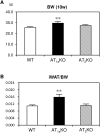Enhancement of Adipocyte Browning by Angiotensin II Type 1 Receptor Blockade
- PMID: 27992452
- PMCID: PMC5167230
- DOI: 10.1371/journal.pone.0167704
Enhancement of Adipocyte Browning by Angiotensin II Type 1 Receptor Blockade
Abstract
Browning of white adipose tissue (WAT) has been highlighted as a new possible therapeutic target for obesity, diabetes and lipid metabolic disorders, because WAT browning could increase energy expenditure and reduce adiposity. The new clusters of adipocytes that emerge with WAT browning have been named 'beige' or 'brite' adipocytes. Recent reports have indicated that the renin-angiotensin system (RAS) plays a role in various aspects of adipose tissue physiology and dysfunction. The biological effects of angiotensin II, a major component of RAS, are mediated by two receptor subtypes, angiotensin II type 1 receptor (AT1R) and type 2 receptor (AT2R). However, the functional roles of angiotensin II receptor subtypes in WAT browning have not been defined. Therefore, we examined whether deletion of angiotensin II receptor subtypes (AT1aR and AT2R) may affect white-to-beige fat conversion in vivo. AT1a receptor knockout (AT1aKO) mice exhibited increased appearance of multilocular lipid droplets and upregulation of thermogenic gene expression in inguinal white adipose tissue (iWAT) compared to wild-type (WT) mice. AT2 receptor-deleted mice did not show miniaturization of lipid droplets or alteration of thermogenic gene expression levels in iWAT. An in vitro experiment using adipose tissue-derived stem cells showed that deletion of the AT1a receptor resulted in suppression of adipocyte differentiation, with reduction in expression of thermogenic genes. These results indicate that deletion of the AT1a receptor might have some effects on the process of browning of WAT and that blockade of the AT1 receptor could be a therapeutic target for the treatment of metabolic disorders.
Conflict of interest statement
This study was supported by JSPS KAKENHI [Grant Number 25293310 to MH, 25462220 to MM, 15K19974 to JI, and 26860567 to LJM] and research grants from pharmaceutical companies: Ajinomoto Pharmaceuticals Co. Ltd., Astellas PharmaInc., Bayer Yakuhin Ltd., Daiichi-Sankyo Pharmaceutical Co. Ltd., Nippon Boehringer Ingelheim Co. Ltd., Novartis Pharma K. K., Shionogi & Co. Ltd., and Takeda Pharmaceutical Co. Ltd. There are no patents, products in development or marketed products to declare. This does not alter our adherence to all the PLOS ONE policies on sharing data and materials, as detailed online in the guide for authors.
Figures





Similar articles
-
The intake of high-fat diets induces the acquisition of brown adipocyte gene expression features in white adipose tissue.Int J Obes (Lond). 2015 Nov;39(11):1619-29. doi: 10.1038/ijo.2015.112. Epub 2015 Jun 11. Int J Obes (Lond). 2015. PMID: 26063331
-
White, brown, beige/brite: different adipose cells for different functions?Endocrinology. 2013 Sep;154(9):2992-3000. doi: 10.1210/en.2013-1403. Epub 2013 Jun 19. Endocrinology. 2013. PMID: 23782940 Review.
-
Two key temporally distinguishable molecular and cellular components of white adipose tissue browning during cold acclimation.J Physiol. 2015 Aug 1;593(15):3267-80. doi: 10.1113/JP270805. Epub 2015 Jul 14. J Physiol. 2015. PMID: 26096127 Free PMC article.
-
Inhibition of Sam68 triggers adipose tissue browning.J Endocrinol. 2015 Jun;225(3):181-9. doi: 10.1530/JOE-14-0727. Epub 2015 May 1. J Endocrinol. 2015. PMID: 25934704 Free PMC article.
-
Understanding the Biology of Thermogenic Fat: Is Browning A New Approach to the Treatment of Obesity?Arch Med Res. 2017 Jul;48(5):401-413. doi: 10.1016/j.arcmed.2017.10.002. Arch Med Res. 2017. PMID: 29102386 Review.
Cited by
-
Brown and Brite: The Fat Soldiers in the Anti-obesity Fight.Front Physiol. 2019 Jan 30;10:38. doi: 10.3389/fphys.2019.00038. eCollection 2019. Front Physiol. 2019. PMID: 30761017 Free PMC article. Review.
-
Angiotensin AT1 receptor antagonism by losartan stimulates adipocyte browning via induction of apelin.J Biol Chem. 2020 Oct 30;295(44):14878-14892. doi: 10.1074/jbc.RA120.013834. Epub 2020 Aug 24. J Biol Chem. 2020. PMID: 32839272 Free PMC article.
-
Obesity, Adipose Tissue and Vascular Dysfunction.Circ Res. 2021 Apr 2;128(7):951-968. doi: 10.1161/CIRCRESAHA.121.318093. Epub 2021 Apr 1. Circ Res. 2021. PMID: 33793327 Free PMC article. Review.
-
Angiotensin II Promotes White Adipose Tissue Browning and Lipolysis in Mice.Oxid Med Cell Longev. 2022 Jun 27;2022:6022601. doi: 10.1155/2022/6022601. eCollection 2022. Oxid Med Cell Longev. 2022. PMID: 35799891 Free PMC article.
-
Role of angiotensin type 2 receptor in improving lipid metabolism and preventing adiposity.Mol Cell Biochem. 2019 Nov;461(1-2):195-204. doi: 10.1007/s11010-019-03602-y. Epub 2019 Aug 14. Mol Cell Biochem. 2019. PMID: 31414336 Free PMC article.
References
-
- Sasamura H, Hein L, Krieger JE, Pratt RE, Kobilka BK, Dzau VJ, et al. (1992) Cloning, characterization, and expression of two angiotensin receptor (AT-1) isoforms from the mouse genome. Biochem Biophys Res Commun 185: 253–259. - PubMed
-
- Burson JM, Aguilera G, Gross KW, Sigmund CD (1994) Differential expression of angiotensin receptor 1A and 1B in mouse. Am J Physiol 267: E260–267. - PubMed
MeSH terms
Substances
LinkOut - more resources
Full Text Sources
Other Literature Sources
Molecular Biology Databases
Research Materials

